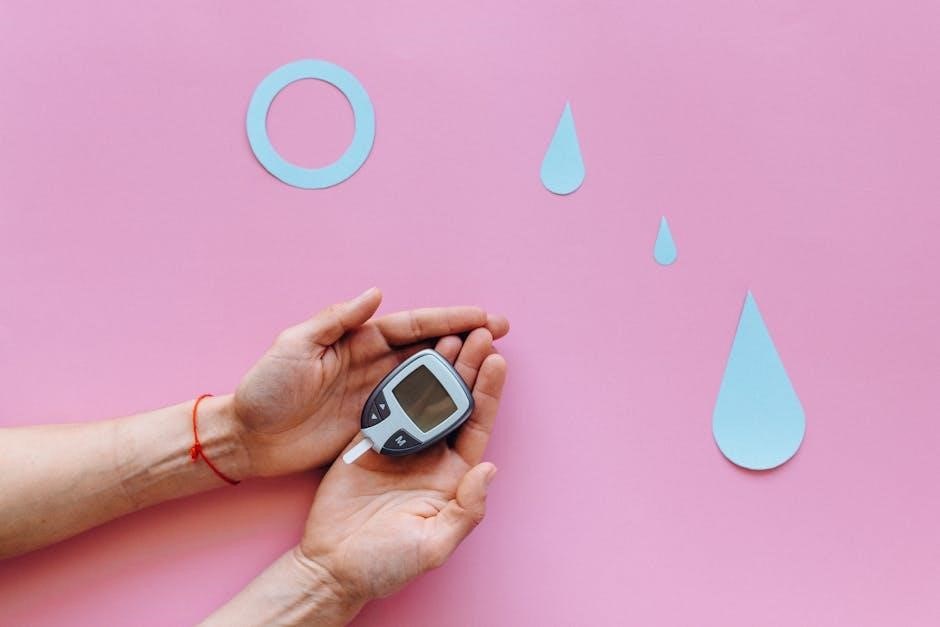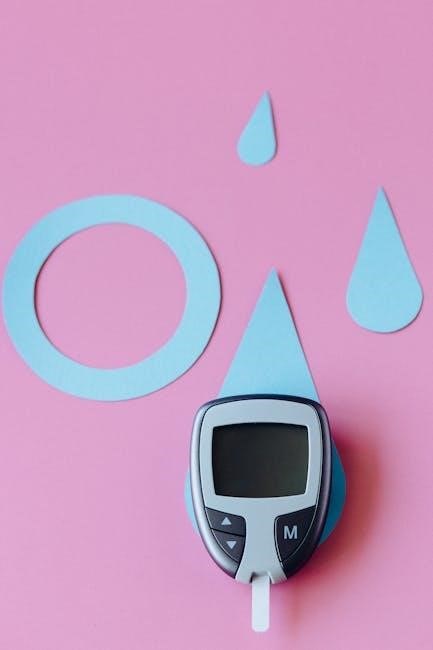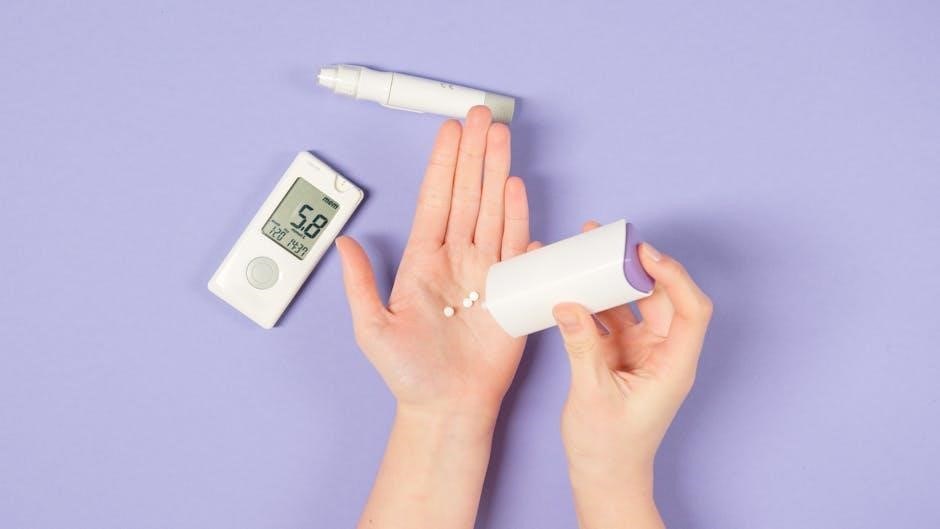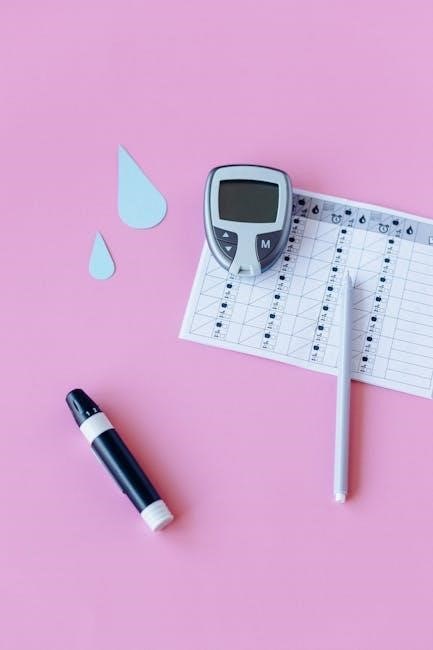Blood Sugar Log PDF: A Comprehensive Guide
A blood sugar log PDF serves as a crucial tool for individuals managing diabetes. It’s a record to track glucose levels, medication, diet, and activity.
What is a Blood Sugar Log?
A blood sugar log, often in PDF format for easy printing and accessibility, is a detailed record of an individual’s blood glucose levels. It acts as a comprehensive diary, capturing readings taken throughout the day, typically before and after meals, and sometimes at bedtime. This log isn’t just about numbers; it’s about understanding patterns.

Beyond glucose values, a good blood sugar log includes space for noting medication dosages, particularly insulin, and any relevant factors that may influence blood sugar, such as diet, physical activity, and stress levels. By meticulously recording these details, individuals and their healthcare providers can gain valuable insights into how different aspects of daily life impact glucose control, facilitating better management of diabetes. Think of it as a personalized diabetes management tool.
Why Use a Blood Sugar Log?
Using a blood sugar log offers numerous benefits for individuals managing diabetes. Primarily, it provides a clear, organized record of blood glucose levels over time, allowing both the individual and their healthcare provider to identify trends and patterns. This data is invaluable for making informed decisions about medication adjustments, dietary changes, and exercise routines. By tracking blood sugar levels in relation to meals, activities, and medication, you can pinpoint specific triggers that cause fluctuations.
Furthermore, a blood sugar log empowers individuals to take a more active role in their diabetes management. It fosters a greater understanding of how lifestyle choices impact blood glucose, promoting healthier habits and improved overall well-being. The log serves as a communication tool, facilitating more effective discussions with healthcare professionals and ensuring personalized care. Ultimately, consistent use of a blood sugar log can lead to better glycemic control and reduced risk of diabetes-related complications.
Types of Blood Sugar Logs

Blood sugar logs come in various formats to suit individual needs and preferences. One common type is the weekly blood sugar log, which provides a snapshot of glucose levels over a seven-day period. These logs typically include space for multiple readings per day, often before and after meals, as well as at bedtime. Monthly blood sugar logs offer a broader view, tracking levels throughout an entire month. These are useful for identifying longer-term trends and patterns.
For individuals requiring more detailed monitoring, there are detailed blood sugar logs that incorporate additional information such as insulin dosages, carbohydrate intake, and notes on physical activity or other factors that may impact blood glucose. The choice of log depends on the complexity of the individual’s diabetes management plan and the level of detail needed to effectively track and analyze blood sugar fluctuations. Some logs are available as printable PDFs, while others are digital and can be used on computers or mobile devices.
Weekly Blood Sugar Log

A weekly blood sugar log is a concise tool for tracking glucose levels over a seven-day period. It typically includes columns for each day of the week and rows for multiple readings throughout the day, such as before breakfast, after breakfast, before lunch, after lunch, before dinner, after dinner, and at bedtime. This format allows for a quick overview of blood sugar patterns and helps identify any significant fluctuations or trends within the week.
Many weekly logs also include space for recording insulin dosages, carbohydrate intake, and brief notes on factors like exercise or stress that may impact blood sugar levels. The weekly log is ideal for individuals who need a structured way to monitor their glucose levels without the overwhelming detail of a more comprehensive log. It’s a manageable format that promotes consistent tracking and facilitates discussions with healthcare providers.
Monthly Blood Sugar Log
A monthly blood sugar log provides a broader view of glucose level trends over an entire month. This type of log typically summarizes daily readings, focusing on key metrics like average blood sugar, number of high or low readings, and overall glycemic control. It offers a comprehensive picture of how well a diabetes management plan is working, revealing patterns that might not be apparent in a shorter timeframe.
Monthly logs often include sections for tracking medication adherence, exercise frequency, and dietary habits, allowing for correlation between lifestyle factors and blood sugar levels. They are particularly useful for identifying long-term trends, assessing the effectiveness of treatment adjustments, and preparing for appointments with healthcare professionals. By consolidating a month’s worth of data, individuals can gain valuable insights into their diabetes management and make informed decisions about their health.
Detailed Blood Sugar Log
A detailed blood sugar log offers the most granular view of glucose management, capturing a wide array of data points throughout the day. Unlike basic logs, it includes entries for pre-meal, post-meal, and bedtime blood sugar levels, providing a comprehensive snapshot of glycemic fluctuations.
This type of log often incorporates sections for recording insulin dosages, carbohydrate intake, physical activity, and any other factors that may influence blood sugar. It enables individuals to identify specific triggers for high or low readings, allowing for precise adjustments to their diabetes management plan. Detailed logs are particularly valuable for those with complex insulin regimens or those seeking to optimize their glycemic control. By meticulously tracking various parameters, users can gain a deep understanding of their body’s response to different stimuli and fine-tune their treatment accordingly. This detailed approach facilitates informed decision-making and empowers individuals to take proactive control of their health.
Essential Elements of a Blood Sugar Log
A well-designed blood sugar log should incorporate several essential elements to provide a comprehensive overview of glucose control. The date and time of each blood sugar reading are crucial for identifying patterns and trends throughout the day.
Recording blood sugar levels before and after meals allows for assessment of how different foods impact glycemic response. Medication or insulin dosage should be meticulously documented to correlate treatment with blood sugar fluctuations. A dedicated notes section enables users to record relevant factors such as diet, physical activity, stress levels, or any other variables that may influence their readings. Consistency in recording these elements is key to extracting meaningful insights from the log. By systematically capturing this information, individuals can gain a deeper understanding of their diabetes management and make informed decisions in consultation with their healthcare provider. These core components transform a simple log into a powerful tool for personalized diabetes care.
Date and Time
Accurately noting the date and time of each blood sugar measurement is fundamental to effective diabetes management. The date provides a chronological context, allowing for the identification of long-term trends and patterns in blood glucose levels.
The time of day is equally important, as blood sugar levels naturally fluctuate throughout the day in response to meals, activity, and medication. Recording the time helps differentiate between fasting blood sugar levels (e.g., upon waking) and postprandial (after-meal) readings. This distinction is crucial for assessing how the body responds to different stimuli at various points in the day. Precise date and time entries enable healthcare providers to gain a more nuanced understanding of an individual’s glycemic control. This facilitates informed decisions regarding medication adjustments, dietary modifications, and lifestyle interventions. Without accurate date and time data, the blood sugar log loses much of its value as a diagnostic and management tool.
Blood Sugar Levels (Before and After Meals)
Recording blood sugar levels before and after meals is a cornerstone of effective diabetes management. Pre-meal readings, also known as fasting blood sugar levels, provide a baseline measurement. This indicates how well the body is managing glucose control in the absence of recent food intake.
Post-meal readings, typically taken one to two hours after eating, reveal how the body responds to the carbohydrate content of the meal. By comparing pre- and post-meal blood sugar levels, individuals and their healthcare providers can assess the impact of specific foods on glycemic control. This information is invaluable for making informed dietary choices. Consistent tracking of these levels helps identify patterns of glucose spikes or dips following particular meals, allowing for personalized adjustments to meal planning and insulin dosages. This ensures optimal blood sugar management throughout the day. This detailed record keeping contributes significantly to improved overall health outcomes for people with diabetes.
Medication/Insulin Dosage
Accurately documenting medication and insulin dosages within a blood sugar log is paramount for safe and effective diabetes management. The log should meticulously record the name, type, and dosage of all medications taken, including insulin. For insulin users, it is essential to note the type of insulin (e.g., rapid-acting, long-acting), the specific dosage administered, and the time of injection or administration.
This detailed record provides a clear picture of the medication regimen and its relationship to blood sugar fluctuations. Healthcare providers rely on this information to assess the effectiveness of the current treatment plan and make informed adjustments as needed. Furthermore, documenting medication and insulin dosages helps prevent errors. It ensures adherence to the prescribed regimen. Consistent and accurate recording promotes patient safety and optimizes therapeutic outcomes in diabetes care. It allows for better communication with healthcare providers and facilitates collaborative decision-making regarding medication management.

Notes (Diet, Activity, Stress)
The “Notes” section of a blood sugar log serves as a valuable space to record contextual information that may influence blood glucose levels. This includes details about dietary intake, such as the types and quantities of carbohydrates consumed. Recording physical activity levels, including the duration and intensity of exercise, is equally important, as activity significantly impacts blood sugar.
Additionally, noting any sources of stress, whether emotional or physical, can help identify patterns and triggers. By documenting these factors alongside blood sugar readings, individuals can gain a deeper understanding of how their lifestyle choices and external influences affect their glycemic control. This information empowers individuals to make informed decisions about diet, exercise, and stress management techniques to optimize their blood sugar levels. The “Notes” section facilitates a holistic approach to diabetes management. It promotes self-awareness and personalized strategies for achieving optimal health outcomes.
How to Use a Blood Sugar Log Effectively
To maximize the benefits of a blood sugar log, consistency is key. Regularly record your blood glucose levels at designated times, such as before and after meals, and at bedtime. Be meticulous in noting the date and time of each reading to establish a clear timeline. Accurately document your medication or insulin dosage, including the type and amount administered.
Utilize the “Notes” section to provide context for your readings, detailing your dietary intake, physical activity, and any stressors experienced. Over time, patterns will emerge, revealing how specific foods, activities, or stressors impact your blood sugar. Share your log with your healthcare provider during appointments to facilitate informed discussions and adjustments to your diabetes management plan. This collaborative approach ensures that your treatment is tailored to your individual needs and promotes optimal glycemic control. Review the log regularly to proactively identify and address potential issues.
Where to Find Blood Sugar Log PDF Templates
Numerous resources offer blood sugar log PDF templates readily available for download. Official websites such as the Centers for Disease Control and Prevention (CDC) and the American Diabetes Association (ADA) often provide free, printable logs tailored for different needs. Many healthcare providers’ offices and diabetes education centers also offer customized log templates to their patients.
Online search engines can be valuable tools for discovering a wide variety of templates, ranging from basic weekly logs to more detailed monthly trackers. Software programs like Microsoft Word and Excel may have built-in templates or allow you to create your own customized log. When selecting a template, consider your individual needs and preferences. Look for a log that is easy to understand, provides sufficient space for recording relevant information, and aligns with the recommendations of your healthcare team. Choose a format that you find visually appealing and user-friendly.